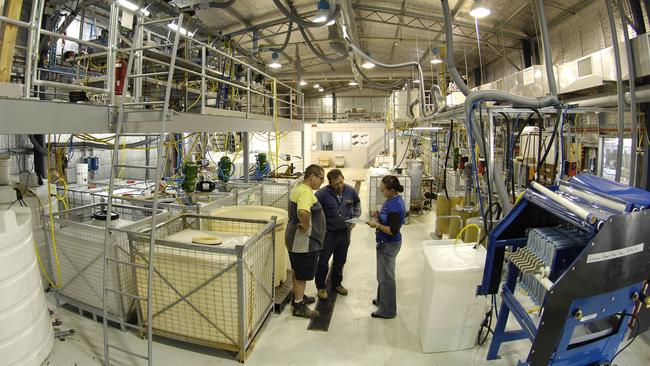Australian Strategic Materials’ Korean link the key to long-stalled project
After 25 years of work, a mineral sands and rare earths production facility near Dubbo offers a chance to challenge China.

After 25 years of work a mineral sands and rare earths production facility near Dubbo in central NSW is finally within reach for Australian Strategic Materials, as South Korea’s manufacturing sector looks to end its reliance on Chinese supply of the critical materials.
It is relatively rare for a spin-out to outperform its parent. But with a market capitalisation of about $1.4bn, ASM is now worth more than double its parent, Alkane Resources, which handed its own shareholders one ASM share for every five Alkane shares they held ahead of the rare earth hopeful’s July 30 listing in 2020.
Shares in the company rose to all-time high on Friday, touching $10.34 before falling slightly to close at $10.22 – up $1.56 for the day.
ASM was floated at $1.25 a share, giving those that held their stock close to a 720 per cent paper return at the end of last week.
Alkane had been working on the large Dubbo zirconium project in NSW for more than 25 years, diverting some of the cash flowing from its Tomingley gold operations to keep the project ticking over despite a grim market for rare earth hopefuls when the mining boom fell away after 2012.
It’s been a rich reward for those Alkane holders that held on, with the spin-out marching from strength to strength under the leadership of former Fortescue chief operating officer David Woodall.
Tensions between China and the US under the Trump administration have underpinned the resurgence of interest in Australian rare earth companies, as the US belatedly recognised that China’s domination of supply of the rare metals – critical ingredients in high technology and defence componentry – was an important strategic and industrial weakness.
Their importance in the battery chain, and as key ingredients in the high-powered magnets that make wind turbines an efficient generator of renewable power, has also buoyed interest in the sector. Shares in the only major non-Chinese rare earth oxides producer, Lynas Rare Earths, have also surged, as have profits.
Interest in the sector has brought attention from majors such as Iluka Resources, now shipping a rare earth concentrate from waste ore from its WA mineral sands mines.
But it is South Korea’s desire to ensure security of supply of the materials for its manufacturing sector that has underpinned ASM’s sharp rise in value.
Major Korean manufacturers such as Hyundai, Samsung, LG, POSCO and others know that their future partly rests in the electric vehicle, battery power and renewable energy revolution. They also know that China is eyeing the same prize, in both domestic and in export markets – and that history shows that Chinese companies will get preferential treatment when it comes to supply from the country’s dominant position in rare earth metals production.

ASM launched its life on the ASX with a partnership with South Korea’s ZironTech already in place, piloting a refinement of existing technology to turn rare earth oxides into pure metals and alloys suitable for sale direct to major manufacturers – a step Woodall says will give the company a key advantage.
“This is about metal production and metal production is dominated by China,” he said.
“Even Lynas doesn’t produce metal, non-Chinese. Even the Japanese have relocated their neodymium-iron-boron (NdFeB) production into China. China has 96 per cent of the world’s NdFeB production.”
In September 2020, ASM acquired 95 per cent of Ziron and a newly built metallisation pilot plant. It is now working on building a full-scale commercial manufacturing plant in South Korea.
Last month came the deal that Woodall says cements ASM’s role in the supply chain.
A consortium of South Korean private equity firms will pump $340m into ASM’s Dubbo rare earths project in return for a 20 per cent equity interest, as well a 10-year metal offtake agreement with the metals plant being built by ASM in South Korea.
The same consortium – with help from manufacturers such as Hyundai, Samsung and others – plans to use that offtake to underpin the development of a magnet manufacturing plant in South Korea, one big enough to end the country’s reliance on Chinese rare earth supply.
“Korea has had a number of geopolitical issues with Japan and also China. Last year they went to order about 200 tonnes of dysprosium. And they weren’t able to buy that,” Woodall said.
“What’s changed is what’s going on in China. China’s going to 25 million electric vehicles per year by 2030 – that in itself, on today’s market, is just under 30 per cent of the global oxide market, maybe a little bit less.”
Add to that China’s massive renewable energy build-out and Woodall says Korean manufacturers are looking to lock in supply from alternative sources now.
“The domestic demand in China is going to consume most of what China produces,” he said.
When ASM’s metals plant is completed in Korea in mid-2022 it will initially be fed by oxides bought on the market, but eventually it will be supplied by output from ASM’s Dubbo rare earths mine and processing facilities in NSW.
The metals plant on its own will still make money, ASM says – the scoping study on a 5200 tonne a year operation put capital costs at $US35m to $US45m, with estimated annual revenue of up to $U190m and earnings of $US45m to $US50m.
But the real prize remains in regional NSW. An optimised study into the project is due at the end of the quarter, but now that the South Koreans are on board – and Export Finance Australia has said it will provide a $200m targeted debt solution – execution of the long-stalled $1.3bn project is finally within reach.




To join the conversation, please log in. Don't have an account? Register
Join the conversation, you are commenting as Logout